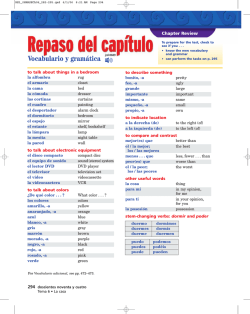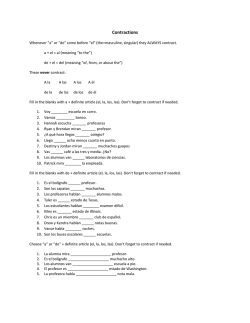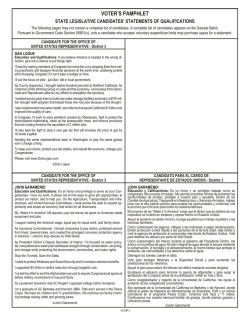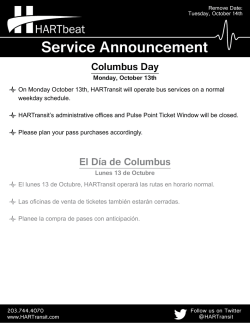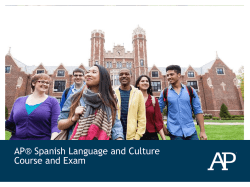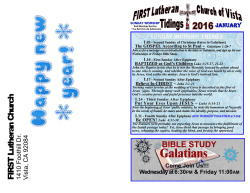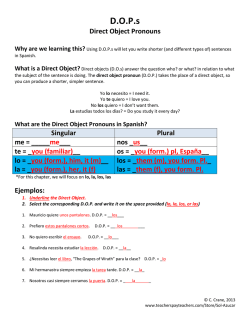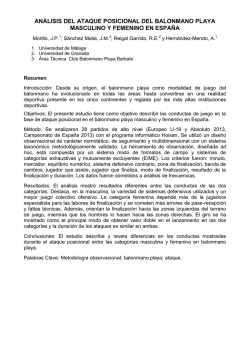
APSLC: tareas veraniegas 2015-2016 personaje famoso: Señor
APSLC: tareas veraniegas 2015-2016 Señor Ross ([email protected]) personaje famoso: _________________ Welcome to APSLC! I am super excited that you have decided to be a part of this class. I realize that right now you are looking forward to summer and not thinking too much about next year. While I totally understand that, I also need you to know that the goal of this summer work is to help you maintain or improve upon your current linguistic abilities. Completing this work at the last minute will not help you accomplish these goals! Spread out the work over the summer both for your sanity and so that it helps you be best prepared for the start of class. I have spread the due dates out over the summer to help you with this. You can find helpful information and links to other sites on my Wiki: http://senorrossapspanish.pbworks.com/ Culture is a central theme to this class; I have included a list of AP themes on page 4 of this packet. As you complete the work, be sure to consult the list and include cultural situations and topics as you read, listen, watch, and speak. In order to receive full credit, the written work must be submitted on or before the due date. OVERVIEW OF SUMMER ASSIGNMENTS: 1. TRIÁNGULO 2. EMAIL 3. PERSONAL INTRODUCTION 4. FIRST FIVE HOURS 5. FINAL FIVE HOURS 6. WRITTEN DOCUMENTATION before leaving for summer Tuesday, June 30 Friday, July 10 at midnight Friday, July 31 at midnight Monday, August 17 Monday, August 17 at 3:00 ASSIGNMENT 1: TRIÁNGULO Prior to leaving for summer, please bring exact change or a check made out to LRHS for $60. If you are unable to pay, please speak to me privately so we can discuss options. THE AP EXAM A. Become familiar with College Board website about this exam. The exam changed in 2014 the exam so be careful that you are reading current information. http://www.collegeboard.com/student/testing/ap/spanish_lang/exam.html?spanlang B. Look at the tips that the College Board suggests for you: https://apstudent.collegeboard.org/apcourse/ap-spanish-language/exam-tips C. Check out practice activities for the exam: https://apstudent.collegeboard.org/apcourse/ap-spanish-language/exam-practice ASSIGNMENT 2: EMAIL (shared before Tuesday, June 30 at midnight) After completing parts A, B, and C, use Google Drive to send me an email in Spanish of at least 100 words. In the email, use formal structure and include the following. 1. Describe the exam as you understand it. 2. Explain with which parts you feel most comfortable. 3. Explain which parts worry you most and why. 4. Include ideas of how you will best study over the course of the year. 5. Include your goals, plans, areas of concern, and any other pertinent comments. 6. Ask me any questions that you have. 1 ASSIGNMENT 3: 10 HOUR PRACTICE FORM (first five emailed by Friday, July 31 at midnight) (one subsection is due by Friday July 10 at midnight) (final five emailed by (all written documentation due in at school by Monday, 8/17 2015 at 3:30 p.m.). This is designed to be a TEN HOUR PRACTICE FORM. I have separated it into two FIVE HOUR FORMS. Although they are due to be turned in on two specific dates, I expect you to spread out the work over the summer in an effort to keep your skills active. Start early to learn the most efficient way for you to work and DON’T leave everything to the last minute. Both the form and the entire packet will be available on the Wiki at the conclusion of this school year. Note that one subsection is due by Friday, 7/10 at midnight. In order to receive credit, the written documentation must be turned in at school. Work on the tally sheet but not physically present will NOT count toward the 10 hour total. When you complete a speaking or a listening exercise, write a brief summary describing exactly what you did in the activity. All writing must be in Spanish in blue or black pen. All written work is due prior to Monday, 8/18 at 3:30. You must divide your practice into the following areas: 1. Grammar/vocabulary exercises (2 hours): For grammar, use either an AP practice book or a website (there are suggestions on my Wiki). For vocabulary, complete the included grid as you build a personal vocabulary list. Make copies of the sheet (or print them off the Wiki) and as you come across new vocabulary words, fill in the grid. You must write the word, draw a picture to help you to remember the word, define the word in simple Spanish, and use it in a sentence to show that you know the definition. You must complete at least 30 words. Grammar exercises must be written/printed and attached to receive credit Grammar exercises should be checked for correctness against an answer key, if possible. All exercises should be marked right or wrong and then explained if wrong. 2. Listening (2 hours): Be creative here! You can use songs, movies, radio (see Wiki for links) or listening to native speakers having conversation. You must write a summary of what you did and what you learned! 3. Writing (2 hours): Writing can be accomplished in a number of ways. I highly suggest using interpersonal writing topics from any AP practice book or the College Board website to count for some of this section. In addition you can include write ups from your listening or speaking, write poetry, read articles (also counts for reading) and write a summary or reaction, write emails/letters to friends and family, chat online in Spanish, etc. All writing in the portfolio must be hand written in pen and double spaced to count for credit. 4. Reading (2 hours): For a part of this segment, you will read Bernardino by Ana María Matute and answer the accompanying questions. There is a copy in this packet and it is also available on the Wiki. For the rest of the time you can read anything in Spanish and count it toward your hours. There are many other sources in addition to the links provided on the Wiki. You must write a summary of your reading in order to count toward your practice hours. 2 5. Speaking (2 hours): The first portion of the speaking is due by Friday 7/10 at midnight. This may take you some time to figure out, so plan accordingly. You must use Audacity (http://goo.gl/vPlHzb), which is a free download. On the same page you will need to download the lame file. You will also need a watch or timer. o Record a two minute discussion in which you talk about yourself, your family, your hobbies, your likes and dislikes, etc. o Time yourself – you have one minute to prepare – do NOT write anything out; all speaking should be spontaneous. o Once you begin recording, start the time and go. o Do not re-record or try to go back to edit mistakes. Do not stop your recorder or pause the at any time until the two minutes are over. o When you conclude the presentation, export it and save it as an mp3 file. Send me the file via Google Drive. Further instructions are available on the Wiki. For the rest of your 2 hours of speaking you can do any combination of the following: a textbook to practice the informal and formal sections of the AP exam, phone conversations, hanging out speaking with friends, restaurants, etc. You must write a summary of your conversations in order to count the time toward your practice hours. * Speaking Spanish with non-native speakers of the language can count for only 1/2 the total time! * Use the accompanying chart to keep record of your work. When you are ready to turn in the work, place it all in a file folder with the verification sheet on top of the stack. On the tab of the folder please write your last name, first name. ASSIGNMENT #4 (prepared during summer and ready for presentation during the first weeks of the course) A. A 2 minute show and tell about your summer. Highlight the most important aspects of different activities that you have done in the months of June, July or August. You must include ONE appropriate visual to use during your presentation. B. A 2 minute presentation about a famous Spanish-speaking person. These names will be issued at the mandatory meeting at the conclusion of the 2014-2015 school year. If you miss the meeting you need to contact me before you leave for summer. Plan to elaborate based on your individual, but give us the big picture of the person: 1. Who are they? Where are they from? 2. Why are they famous? 3. How have they impacted the Spanish-speaking culture? 4. What time frame are we talking about? Alive/dead? 5. How does this person relate to our study of Spanish? 6. What are a/some interesting or trivial personal fact/s about this person? You can reach me during the summer by e-mail at [email protected] if you have any questions. Good luck with your assignments! I look forward to working with you in APSLC next year! 3 APSLC: Temas de la clase Los desafíos mundiales Los temas económicos Los temas del medio ambiente El pensamiento filosófico y la religión La población y la demografía El bienestar social La conciencia social Las preguntas esenciales: ¿Cuáles son los desafíos sociales, políticos y del medio ambiente que enfrentan las sociedades del mundo? ¿Cuáles son los orígenes deseos desafíos? ¿Cuáles son algunas posibles soluciones a esos desafíos? La ciencia y la tecnología El acceso a la tecnología Los efectos de la tecnología en el individuo y la sociedad El cuidado de la salud y la medicina Las innovaciones tecnológicas Los fenómenos naturales La ciencia y la ética Las preguntas esenciales: ¿Qué impacto tiene el desarrollo científico y tecnológico en nuestras vidas? ¿Qué factores han impulsado el desarrollo y la innovación en la ciencia y la tecnología? ¿Qué papel cumple la ética en los avances científicos? La vida contemporánea La educación y las carreras profesionales El entretenimiento y la diversión Los viajes y el ocio Los estilos de vida Las relaciones personales Las tradiciones y los valores sociales El trabajo voluntario Las preguntas esenciales: ¿Cómo definen los individuos y las sociedades su propia calidad de vida? ¿Cómo influyen los productos culturales, las prácticas y las perspectivas de la gente en la vida contemporánea? ¿Cuáles son los desafíos de la vida contemporánea? Las identidades personales y públicas La enajenación y la asimilación Las creencias personales Los héroes y los personajes históricos Los intereses personales La identidad nacional y la identidad étnica La autoestima Las preguntas esenciales: ¿Cómo se expresan los distintos aspectos de la identidad en diversas situaciones? ¿Cómo influyen la lengua y la cultura en la identidad de una persona? ¿Cómo se desarrolla la identidad de una persona a lo largo del tiempo? Las tradiciones y los valores Las comunidades educativas La estructura de la familia Las familias y las comunidades La ciudadanía global La geografía humana Las redes sociales Las preguntas esenciales: ¿Cómo se define la familia en distintas sociedades? ¿Cómo contribuyen los individuos al bienestar de las comunidades? ¿Cuáles son las diferencias en los papeles que asumen las comunidades y las familias en las diferentes sociedades del mundo? La arquitectura Definiciones de la belleza Definiciones de la creatividad Tema: La belleza y la estética La moda y el diseño El lenguaje y la literatura Las artes visuales y escénicas Las preguntas esenciales: ¿Cómo se establecen las percepciones de la belleza y la creatividad? ¿Cómo influyen los ideales de la belleza y la estética en la vida cotidiana? ¿Cómo las artes desafían y reflejan las perspectivas culturales? © 2011 The College Board 4 APSLC Hoja de verificar las 10 horas de práctica horas Tema Gramática Fecha / Horas Nombre ____________________ Evidencia (¿Qué hiciste? ¿Dónde?) Escuchar Escritura Lectura Hablar 5
© Copyright 2025
